A step-by-step guide to replanting a tangerine tree at home
With proper care, tangerine develops quickly at home. Moreover, not only its branches and shoots grow, but also the root system. To make the tree feel comfortable, bloom and bear fruit, it is regularly replanted.
In a cramped container, the plant stops developing, discards inflorescences and becomes sick. If you plant citrus in a large pot right away, it will not form properly and will not bloom. Transplanting a tangerine tree at home is carried out in accordance with the rules, which we will discuss below.
The content of the article
Why transplant a tangerine tree
The citrus tree develops rapidly, its root system rapidly fills the pot... When the roots occupy the entire container, the growth of the plant stops. It cannot fully absorb from soil liquid and nutrients. The roots begin to rot or dry out, increasing the risk of fungal infection.
Over time, the soil in the pot is depleted. Some of the minerals that were introduced into the soil are converted into insoluble compounds and salts. They are harmful to plants and interfere with the absorption of essential elements. It will not be possible to correct the situation by applying top dressing, it is necessary to completely replace the soil.
When is it necessary
Planned transplants are carried out regardless of the state of the tangerine.
When is the procedure needed: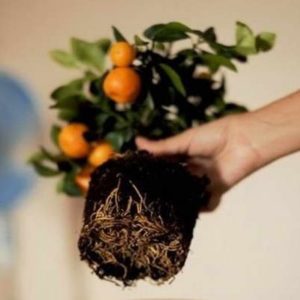
- Planned transplant. The older the plant, the slower it develops and the less often it is moved to a new pot.
- When filling the pot with the root system. To check this, a skewer is stuck into the ground. If it passes with difficulty, then the roots have filled the entire space.
- With root rot. The outward sign of the disease is yellowing and falling leaves. In this case, the root system is washed from the ground, all the affected roots are removed, treated with copper sulfate (1 tsp for 5 l of water) and soaked in "Heteroauxin".
- If the soil has been repeatedly waterlogged. Such an error in maintenance causes a change in the composition of the soil. To save the plant, the soil is replaced with new fertile soil.
- If water quickly flows into the pan or, conversely, stagnates. This is a sign that the wrong soil mixture is being used. To solve the problem, replace the soil with a new one, consisting of the correct components.
- With increased acidity of the soil. This indicator is checked using a litmus test. It is not recommended to add lime to the soil if there is already a tree there.
- When buying a new plant. The soil in which the tangerine tree is planted in the store contains a lot of peat. In addition, there is a risk that it will become infected with fungi, bacteria or pests... This is dangerous not only for tangerine, but also for other indoor plants. Therefore, immediately after purchase, it is transplanted.
If mandarin leaves turn yellow and fall off for unknown reasons, despite the observance of the rules of care, it is recommended to transplant the plant. This often becomes the solution to the problem.
Transplant timing
When is it better to transplant indoor tangerine? Experienced gardeners do this in the spring, right after the end of wintering, but before sap flow begins. Then the tree will quickly take root and easily survive stress.
Note! A transplant is also possible in the fall, after the fruit has returned.
If the mandarin looks unhealthy, it is transplanted regardless of the season. In other cases, the following scheme is followed:
- When grown from seed dive when 2 true leaves appear on the seedlings, into a 200-300 ml container. The second time is transplanted when the root system fills the pot. In the first year, 2 to 3 transplants are carried out.
- Before the first flowering (the first 3-5 years), the mandarin is reloaded once a year.
- After the first flowering and fruiting, the tree is replanted every 3 years.
- Trees over 10 years old that have reached their optimum size are not transferred to a new pot, but the topsoil is replaced annually.
Training
To plant a tree in a new pot successfully, it is important to properly prepare for this procedure. Attention is paid not only to the plant, but also to containers with soil.
Pot selection
The chosen container for tangerine will depend on how comfortable the plant will feel in the new conditions.
For the first transplant, take a pot with a volume of 200-300 ml. Each next container should be 3-6 cm larger than the previous one.
In the first year, plastic containers are allowed. Then it is recommended to choose pots made of clay or ceramics - such material has pores that let air into the soil.
Council. Experienced citrus growers advise choosing narrow and tall containers. In them, the root system is stronger.
It is important that there are drainage holes in the bottom of the pot - excess liquid will flow through them. This will prevent stagnant water in the pot. It is better if a pallet is included with the pot. It is used for bottom watering.
Before use, containers are disinfected in one of the following ways:
- soaked for 30 minutes in a dark pink solution of potassium permanganate;
- pour over boiling water or boil in it;
- soaked in a solution prepared from 3 liters of water and 1 tsp. copper sulfate.
The soil
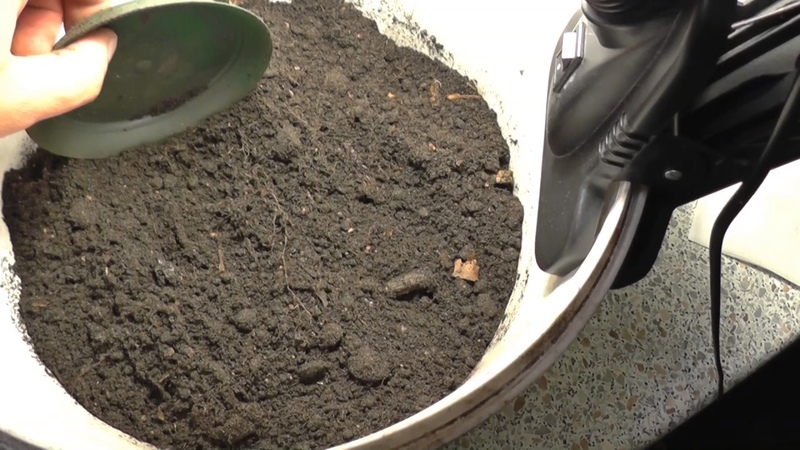
The shops sell special soil for citrus fruits. It has an optimal composition for tangerines. However, you cannot buy it in all retail outlets.
Universal soil mixture for tangerine will not work. It is prepared on the basis of peat, which has a bad effect on the state of citrus fruits.
Often the soil is prepared independently. The following soil mixture is optimal for young plants:
- garden land - 2 parts;
- river sand - 2 parts;
- humus - 1 part;
- rotted manure - 1 part.
For plants over four years old, the soil is done differently:
- garden land - 2 parts;
- river sand - 1 part;
- humus - 1 part;
- rotted manure - 1 part.
Add 1 tbsp to a bucket of the resulting soil mixture. ash. It is better to immediately prepare a large amount of soil, since it will be needed more than once.
The soil is disinfected: calcined in the oven, poured with boiling water, dark pink potassium permanganate or a solution prepared from 1 tbsp. l. copper sulfate and 1 bucket of water.
Drainage is disinfected in the same way as soil.
Note! Orange sand is not suitable for preparing soil mixtures. It contains too much iron. It is recommended to give preference to white or gray river sand.
Preparing the tangerine tree
In order for the tree to easily transfer the transplant and quickly take root, it is also prepared. To do this, a week before the procedure, the plant:
- wash in the shower;
- fed with potash and phosphorus fertilizers;
- put in a shaded place.
Transplant instructions
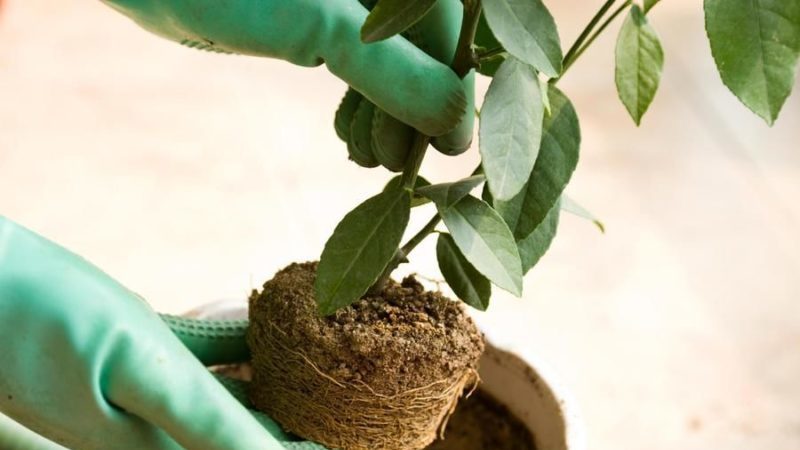
Depending on the age of the mandarin, the technique of transplanting it to a new place differs.
Transfer
The procedure involves partial root cutting and a complete soil replacement. Therefore, plants that have already bloomed and bore fruit are transplanted once every 3 years.
How to transplant a tangerine:
- The day before the transplant, the tangerine is poured abundantly with warm, settled water so that the soil better sticks off the roots.
- The tree is removed from the pot, the roots are cleaned of the earth.
- The roots are examined for infection and pests. All affected areas are cut off. Rotten and dry roots are also removed.
- A drainage layer of 1-2 cm and the same amount of soil is poured onto the bottom of the pot. An earthen mound is formed in the center of the pot.
- The plant is transferred to a pot. The roots are evenly distributed around the mound. The rest of the space is filled with the remaining soil. The root collar of a tangerine tree should not be buried.
- The soil around the mandarin is compacted. Pour with warm, settled water with the addition of a few drops of "Heteroauxin".
Controversy raises the question of whether it is necessary to shorten the mandarin roots by a third when transplanting. Some citrus growers believe that this will make the root system stronger, while others say that in the process of moving the plant to a new pot, a large number of roots break off. In any case, pruning will slow down the growth of the tree.
Transshipment
Transshipment is used to plant tangerines in new containers if they have not yet reached the age of 4. This procedure is carried out annually.
The advantage of transshipment is that the process does not damage the roots of the plant, it does not experience stress and quickly takes root. In a new pot, its growth does not slow down.
Tangerine tree transshipment instructions:
- The tangerine is not watered for 3 days before transshipment so that it can be conveniently removed from the pot.
- The tree is removed from the pot along with an earthen lump. At the same time, they try to keep the roots intact.
- The entire drainage layer is removed. With a sharp knife, cut off 1-2 cm of the top layer of soil. It is important that the blade does not touch the mandarin barrel.
- A layer of drainage 1-2 cm is poured into a new pot. Then the tangerine is placed there along with an earthen lump. The free space is filled with earth, which is crushed.
- The tree is watered with warm, settled water.
How to work with an old plant
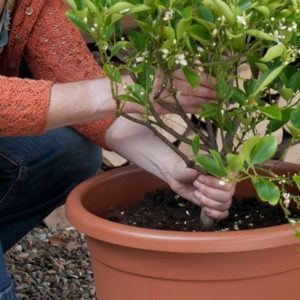
A plant that has reached its optimum size is not transplanted. To get rid of harmful insoluble compounds, replace the topsoil:
- The tree is placed in a basin and watered with plenty of water. Water from the basin is periodically poured out. This is done until a clear liquid flows from the pot.
- The top 3-4 cm of soil is removed. Instead, a new nutrient soil mixture is poured.
- The soil around the trunk is crushed and watered with warm, settled water.
This procedure is carried out once every 2-3 years.
note! If the tree is sick, it is transplanted into a new container, regardless of age.
Tree care after transplant
It is important to provide the tree with proper care after transplanting. This will help the plant take root faster.
Temperature
After transplanting, for the first 2-3 weeks, the room temperature is maintained at + 24 ... + 26 ° C, so that the tree takes root faster. After 14-21 days, the indicators are reduced to the temperature usual for the plant.
Watering
Tangerine is watered with a small amount of warm settled water daily. The first month, once a week, add a couple of drops of "Heteroauxin" to the water. 2 weeks after the transplant, the first top dressing... It should contain phosphorus, potassium and urea.
Humidity
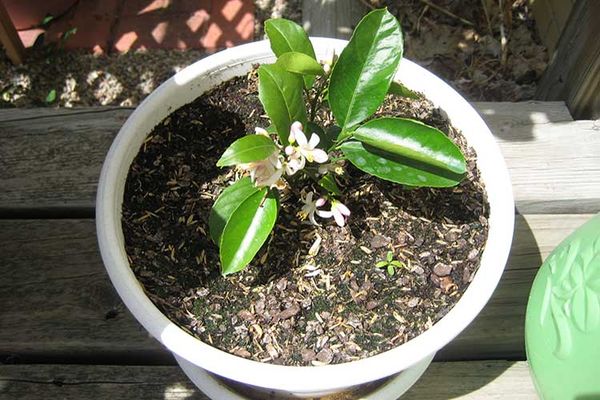
The humidity in the room should be increased. To ensure optimal conditions, the plant is sprayed daily with warm, settled water. At first, it is recommended to add a small amount of Epin to it.
Lighting
For a month after transplanting, the tangerine is kept in a shaded place. It should not be exposed to direct sunlight.
If, after transplanting, the leaves began to fall off, the tangerine needs to create greenhouse conditions. For this, a bag is put on it, which is fixed on the pot. The tree is ventilated and sprayed daily. Such conditions are provided until the problem disappears.
Is it possible to transplant tangerine with fruits
It is not recommended to replant the tangerine tree during flowering and fruit formation. While transshipments are necessary for a houseplant to develop properly, it is stressful. There is a high risk that citrus will shed flowers and crops.
Transferring a plant to a new pot during fruiting is only justified if the tree begins to shed its leaves or other signs appear that it is sick. Before the procedure, all inflorescences and fruits are cut off so that the tangerine does not waste energy on them.
Conclusion
The tangerine tree requires regular maintenance. In favorable conditions, it develops rapidly, forms many shoots and roots. It must be transplanted in a timely manner. Without this procedure, the plant will get sick and stop blooming.